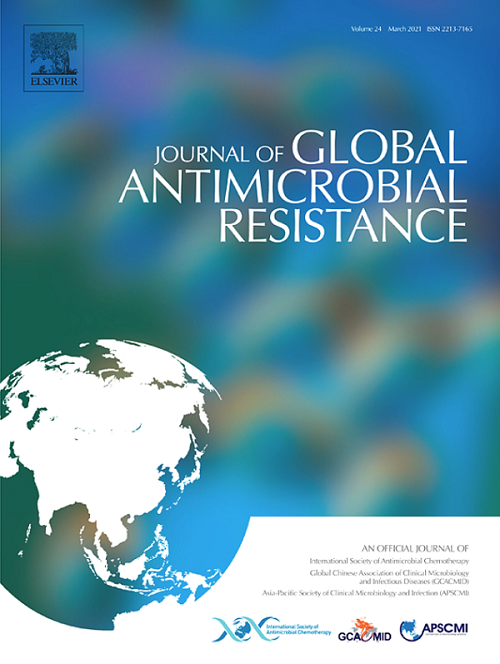序列型155多重耐药大肠杆菌的基因组研究:一株含有四类β-内酰胺酶的头孢他啶-阿维巴坦耐药菌株。
IF 3.7
3区 医学
Q2 INFECTIOUS DISEASES
引用次数: 0
摘要
目的:多重耐药(MDR)大肠杆菌菌株的出现严重限制了抗生素的治疗选择,而耐药基因(ARGs)和移动遗传元件的传播加剧了这种情况。本研究深入研究了MDR大肠杆菌菌株QMM-01,该菌株独特地共表达所有四种已知类别的β-内酰胺酶,旨在揭示其耐药的潜在机制并评估其全球传播的潜力。方法:从烧伤患者中分离出大肠杆菌QMM-01,通过临床常用的标准自动化程序进行抗生素敏感性测试,并进一步通过碳青霉烯酶免疫层析测试。为了获得基因组信息,使用PacBio Sequel和Illumina NovaSeq平台进行全基因组测序(WGS),并辅以生物信息学分析来预测抗微生物药物耐药性基因,确定血清型,进行多位点序列分型,并进行比较基因组分析。结果:QMM-01对广谱β-内酰胺类抗生素耐药,包括碳青霉烯类和头孢他啶-阿维巴坦,除氨曲南外。菌株的耐药特征可能主要是由于B类金属β-内酰胺酶的产生。WGS发现嵌合质粒pQMM-2-NDM-5携带blaNDM-5基因,与来自不同地理区域的质粒具有相似性。该质粒含有161个预测编码序列,含有13种不同抗生素的耐药基因,形成了一个遗传环境复杂的耐药岛。结论:本研究强调了抗生素耐药性带来的全球挑战,并强调了在抗生素管理方面开展国际合作以减轻耐药基因传播的必要性。本文章由计算机程序翻译,如有差异,请以英文原文为准。
Genomic Insights into a Multidrug-Resistant Escherichia Coli of sequence type 155: A Ceftazidime-Avibactam Resistant Strain Harboring Four Classes of β-Lactamases
Objective
The emergence of multidrug-resistant (MDR) Escherichia coli strains has significantly constrained antibiotic treatment options, while the spread of antimicrobial resistance genes (ARGs) and mobile genetic elements exacerbates the situation. This study delves into an MDR E. coli strain, QMM-01, which uniquely co-expresses β-lactamases from all four recognized classes, aiming to uncover the underlying mechanisms of its resistance and assess its potential for global spread.
Methods
E. coli QMM-01, isolated from a burn patient, underwent antibiotic susceptibility testing through standard automated procedures commonly employed in clinical settings, with further test by immunochromatographic tests for carbapenemases. For genomic insights, whole-genome sequencing (WGS) was performed using both PacBio Sequel and Illumina NovaSeq platforms, supplemented by bioinformatics analyses to predict antimicrobial resistance genes, determining serotypes, performing multilocus sequence typing, and conducting comparative genomic analysis.
Results
QMM-01 exhibited resistance to a broad spectrum of β-lactam antibiotics, including carbapenems and ceftazidime-avibactam, with aztreonam being the sole exception. The resistance profile of the strain might primarily be due to the production of class B metallo-β-lactamases. WGS revealed the presence of a chimeric plasmid, pQMM-2-NDM-5, carrying the blaNDM-5 gene and exhibiting similarities with plasmids from diverse geographical regions. This plasmid contains 161 predicted coding sequences and harbors resistance genes for 13 different antibiotics, forming a resistance island with a complex genetic environment.
Conclusion
This study underscores the global challenge posed by antibiotic resistance and emphasizes the need for international collaboration in antibiotic stewardship to mitigate the spread of resistance genes.
求助全文
通过发布文献求助,成功后即可免费获取论文全文。
去求助
来源期刊

Journal of global antimicrobial resistance
INFECTIOUS DISEASES-PHARMACOLOGY & PHARMACY
CiteScore
8.70
自引率
2.20%
发文量
285
审稿时长
34 weeks
期刊介绍:
The Journal of Global Antimicrobial Resistance (JGAR) is a quarterly online journal run by an international Editorial Board that focuses on the global spread of antibiotic-resistant microbes.
JGAR is a dedicated journal for all professionals working in research, health care, the environment and animal infection control, aiming to track the resistance threat worldwide and provides a single voice devoted to antimicrobial resistance (AMR).
Featuring peer-reviewed and up to date research articles, reviews, short notes and hot topics JGAR covers the key topics related to antibacterial, antiviral, antifungal and antiparasitic resistance.
 求助内容:
求助内容: 应助结果提醒方式:
应助结果提醒方式:


